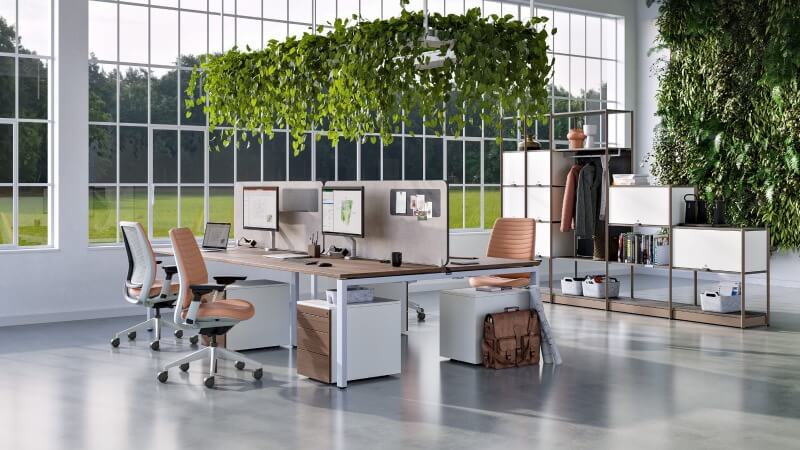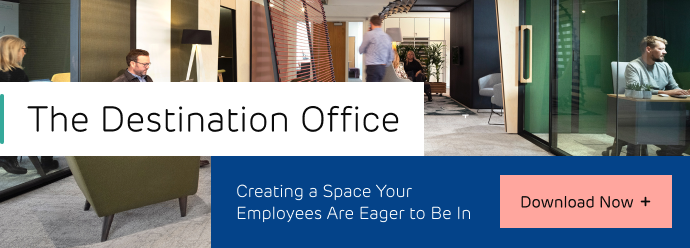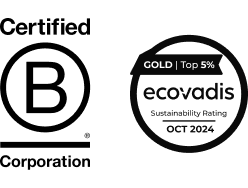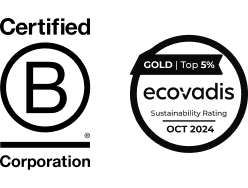The modern office is evolving. It can no longer be just a place to clock in. It needs to be a destination where employees can feel inspiration and connection. So, how can you create a space where people 'love to be' rather than where they 'have to be'?
The destination office gains traction
The idea of the ‘destination workplace’ is fast gaining traction in the post-Covid world.
As we no longer need to “go to work” to be working, today’s office buildings need to serve as unique destinations that motivate and inspire people to connect, learn new things and feel the brand and culture of their company.
Examples from around the world show us how offices rich in amenities and collaborative spaces can help attract and engage workers - while boosting their loyalty and productivity.
But creating a ‘destination office’ can seem like a tall order for all but the largest corporations. If you’ve seen those incredible pictures of big-tech workplace designs like Google’s King Cross HQ, you might wonder how they could be built from the ground up without a billionaire’s budget.
No one ever needed an ‘office slide’
You may also be wondering if the more high-concept office redesigns will really keep their appeal over time? Can you be sure it will be worth the investment? After all, the faddish designs from the era of the start up bubble have not aged well. Remember those ball pits, beach huts, office slides and hammocks that office design firms got all excited about?
More than a quirky finish?
A ‘destination office’ may once have been all about a quirky finish, but a focus on these flourishes have been replaced by more serious considerations.
Now, businesses are thinking about nurturing collaboration, supporting wellbeing and braiding physical and virtual experiences. These are the offices that can enrich employee experiences, improve collaboration and inspire us to gather together and thrive together.

Three steps to design and maintain the destination office
So, where do you start?
How do you ideate? How do you prove your concept? And how do you secure buy-in and budget?
1. Make data-driven decisions
First you need to understand what your employees actually want, rather than deciding unilaterally what support they need or what will make them happier.
Surveys can offer insights into employee preferences, from amenities to workspace layouts. Office designers like Insightful Environments put this kind of research front and centre of their work.
But the financial services company Capital One take this a step further. They not only poll their own workers but regularly use data drawn from the population at large to understand trends and ensure their workplaces remain competitive.
By listening to feedback from professionals outside of Capital One, we’re better able to stay ahead of the workplace design curve and understand what trends will be most impactful for our associates. In turn, we use this data to inform our strategy in updating the way we work at Capital One.
Setting up formal, ongoing listening exercises like these can provide initial stimulus for new workplace re-designs and feedback on the success of implementations so solutions can be tweaked.

Quantitative and qualitative data will help you identify persistent bug-bears about working environments and quickly identify new demands on workers that you can help with. They can uncover nuggets of information about the way we choose to work that would otherwise evade us.
2. Harness the power of piloting
But how can you be confident that the ideas you come up with are going to work in practice? Before committing to significant changes you need to test the water.
Use insights from staff feedback to prototype new workspace ideas. This iterative approach, from scenario development to full-fledged pilots, minimises risks and ensures that the final outcome resonates with your employees. It's a proactive way to address potential challenges, refine ideas, and get support from all stakeholders.
Leading companies are already paving the way with this approach.
For example, Deloitte’s Hybrid Meeting Lab helps businesses explore the future of hybrid work through state-of-the-art technology:
Using insights from the fields of group dynamics, environmental psychology, design thinking, and innovation theory, we have developed the Deloitte Greenhouse Virtual Breakthrough Labs— these are immersive, curated virtual sessions that encourage collaboration, interaction, and unordinary thinking.
Meanwhile, Barclay’s X Labs are an initiative running at 4 locations in the country where the bank’s teams can go and test out new modes of working on specific projects. These flexible spaces allow teams to work with the latest tools, furniture and workplace layouts - reporting and measuring success in real-time using the latest apps and tracking software. It is gathering vital quantitative and qualitative data for the bank to use when deciding on future fit-out investments.

3. Secure leadership buy-in
A successful office transformation requires backing from the top. Leadership should play a pivotal role in resource allocation, setting cultural tones, and ensuring that the new office design aligns with the company's broader objectives. Their support can be the difference between a project's success and its stagnation.
An increasing number of businesses are appointing Workplace Experience Managers to work with designers, crunch data, and curate spaces so office designs are continually optimised to improve performance.
This kind of appointment speaks volumes about a company’s commitment to improving their working spaces and keeping on top of worker’s needs and demands.
With the potential expense of building a ‘destination office’ it will pay to have a job role dedicated to track and tweak the impact of change - as well as report upwards on required support or re-investment.
Conclusion
Creating a destination office is more than just aesthetics; it's about fostering an environment where every employee feels valued, inspired, and motivated. By tuning into their needs, piloting innovative ideas, drawing inspiration from industry leaders, and securing top-tier buy-in, businesses can craft a workspace that stands out in today's competitive landscape.










